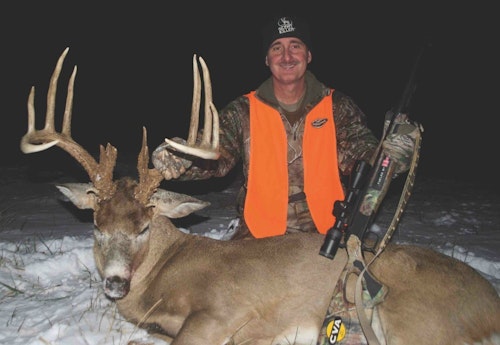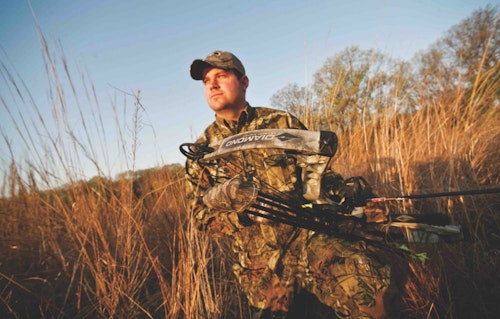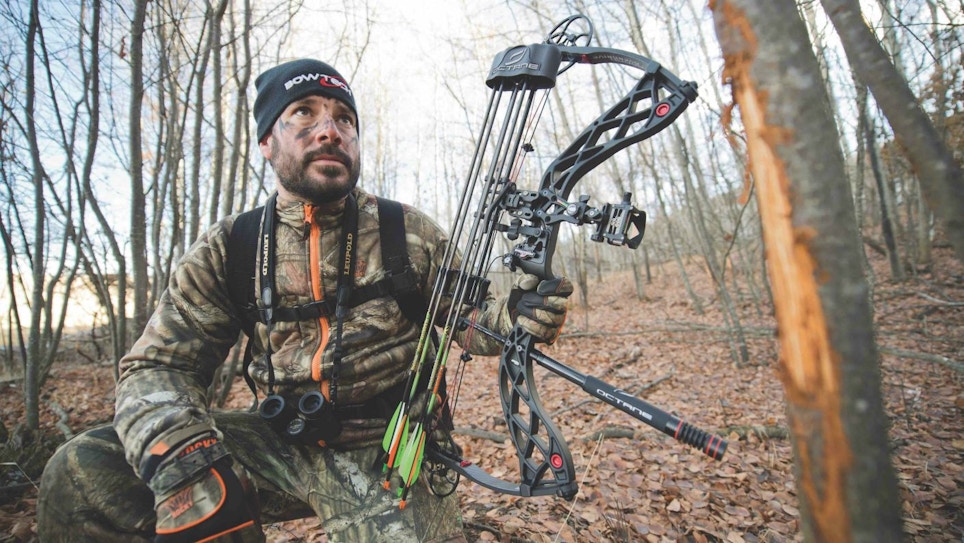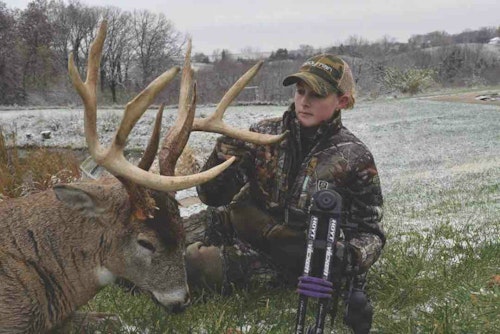It’s safe to say that most bowhunters stick to their home territory — ground they grew up hunting and know like the backs of their hands — for whitetails. Sure, the road-trip craze is more popular than ever, but most bowhunters play that card during the early season and then dedicate October, November and December to their stomping grounds. If taking a monster buck like those you’ve seen on outdoor TV seems to elude you season after season on your home turf, it’s probably time to chase that dream elsewhere.
States with draw-only deer tags offer excellent hunting for that specific reason — you can’t show up and buy an OTC license. The limited hunting pressure means fewer bucks get harvested, and most hunters tend to be choosier with their coveted licenses, giving many young bucks free passes in hopes a monster will show. In other words, these states produce monsters because many bucks reach the older age class and flaunt their true antler potential.
With that said, if you live in an OTC deer state like Michigan, Wisconsin or Pennsylvania where hunting pressure is fierce, it could potentially take a lifetime to encounter a true giant buck. In contrast, draw states like the ones we’ll review in the following paragraphs are known for producing older bucks. If you’re tired of hunting areas with weak trophy potential, consider throwing your name in the hat for one or all three of the following draw states.
Kansas
The Sunflower State — undeniably an ultra-popular big-buck destination — harbors great trophy potential. Winters are typically mild, nutrition is high, and the firearms season lands well after the peak rut, meaning that giants aren’t running does full bore in the wide open during daylight, thus falling susceptible to long-range firearms. This is great news for bowhunters. Still, firearm season can be productive, too. And, the entire state offers solid hunting. The best opportunities, of course, exist far from population centers.
Kansas is rich with public land opportunities — no knocking on doors or paying expensive lease or outfitter fees, although those options could potentially increase your success rate and trophy potential. The Kansas Wildlife, Parks and Tourism website offers a user-friendly Hunting Atlas that denotes all Walk-In Hunting Access Program lands. The website also offers maps of state-owned wildlife areas. This will simplify your search for huntable lands.
If you’re looking for a private land hunt, consider searching for a lease. If you find leasable ground large enough for multiple hunters, this venture becomes far more affordable. Simply split the costs with your group.
Another option is to book a hunt with a reputable outfitter like Rader Lodge, which is located in Unit 7 in northcentral Kansas. “We specialize in semi-guided hunts,” owner, Jeff Rader said. “We provide the land, maintain it year-round, and get our hunters lined up with a treestand to hunt from. However, since it’s a semi-guided hunt, we encourage our clients to bring along a treestand or two to hunt from if they want to tweak stand placement.
“We have nice accommodations and provide three meals daily. We stay in contact with our hunters and provide suggestions when needed. If a client shoots a deer, we retrieve it and field dress it, then the client takes over from there.
“The advantage of hunting with us is that a fairly experienced hunter gets a lot of freedom to do what he/she likes to do. You get the latitude to play the wind and make small changes, as needed. It’s a great place to hunt, and we have some nice bucks on our ground. Most mature bucks in our area score anywhere between 130- and 180-plus-inches. A 150-inch buck is a great representative for this area.”
As for drawing a tag, the Kansas Wildlife, Parks and Tourism’s licensing department shared that tags aren’t as difficult to draw as some who haven’t hunted Kansas might suppose. Many units can be drawn annually, while the rest of the units can be drawn biannually, as one license agent said. That makes planning your trip to the Sunflower State logistically simpler.
Visit www.ksoutdoors.com for more information.

Iowa
There are several factors that make Iowa a well-known whitetail mecca. First, the entire state has outstanding trophy potential with numerous habitat types all conducive to whitetails. Expect steep wooded bluffs along the two major river corridors — Missouri River on the western border and Mississippi River along the eastern border. Southern Iowa has gentler timbered hills with rich nutrition. Western parts of the state feature rolling prairies and terraced agriculture, while seas of cornfields encompass much of the state. Riparian habitats can be found throughout, and these naturally teem with whitetails.
Next, a limited quota of nonresident licenses for 10 separate zones are distributed through a drawing. Some zones can be drawn every other year for the archery hunt, but the most popular zones require three to four preference points in advance. Hunters can elect to buy preference points only for just over $50 per year. This gives DIY hunters a few years to home in on a zone and find public lands on which to focus before they commit to apply for the license.
Gun seasons are generally a bit easier to draw than archery. Consider Zone 3, for example. In 2019, archery applicants without preference points drew none of the zone’s 196 available licenses. In contrast, gun applicants without preference points drew 321 of the 364 available licenses. Twenty licenses even went undrawn and transferred to the leftover pool.
Keep in mind that Iowa is a one-buck state for nonresidents. In other words, you can’t apply for and draw firearms and archery tags in the same season. Preference points, though, aren’t unit- or season-specific, so you can be flexible once you have enough points to draw. It all boils down to the type of hunt you want. If you want a rut hunt, apply for an archery license. If you don’t care about the rut, consider a December gun hunt, but be prepared to share the woods with more hunters.
One downside is that licenses are quite pricey. At $644 (not including preference-point fees), you’re paying more than an Idaho elk tag. On the flip side, that price puts you in the heart of world-class whitetail hunting with good prospects for encountering and even shooting the buck of a lifetime. Even public land hunters annually rack up some impressive giants.
Speaking of, access is hardly an issue in Iowa. The state manages dozens of wildlife management areas, and many of them are around rivers, creek, lakes and reservoirs — great whitetail habitat. State forests like the 9,148-acre Shimek State Forest provide generous room to stretch your legs and get away from weekend crowds. There probably isn’t a better place on the map to hunt for a public-land monster than good ol’ Iowa.
Visit www.iowadnr.gov for more information.

Colorado
I haven’t found a state that provides more information to DIY hunters than Colorado. The Hunting Atlas online at the Colorado Parks and Wildlife’s website not only breaks the state up into game-management units (GMUs), but it also denotes lands accessible to public hunting. Even more impressive, it breaks down summer and winter concentration areas by species, as well as general whereabouts of resident (non-migratory) animals. And, if you have any questions as you plan your hunt, simply call a Hunt Planner. These folks are knowledgeable and can save you lots of time.
That said, most of the state’s whitetails roam the eastern plains and riparian habitats. Public access is difficult to find. “Most of the land in eastern Colorado where we grow big whitetails is privately owned,” Julie Stiver, a wildlife biologist with the Colorado Parks & Wildlife, said. “Outfitters lease a lot of the properties, and that makes access challenging.”
Longtime outfitter, Jack Cassidy of Jack Cassidy Colorado Big Game Hunts and Cassidy Outfitters (www.cassidyoutfitters.com) agrees. “Approximately 90 percent of Colorado’s eastern plains are privately owned,” he said. “Virtually the only private properties that have good whitetail numbers and are managed for them are owned and operated by licensed outfitters or are leased by them. To successfully hunt whitetails in Colorado, you have very few options for places to hunt. Your best option is to hunt with an outfitter.”
According to Cassidy, “Other than lower-quality OTC GMUs along the I-25 corridor with OTC whitetail-only licenses, all whitetail licenses are distributed through a drawing. Each unit varies, but archery licenses are typically easier to draw than rifle licenses. Some of the rifle units we hunt require two to three preference points to draw.
“I lease 200,000 acres of ground in eastern Colorado for whitetail deer along all of the major drainages. I’ve had most of this ground leased for many, many years. I’ve been in the outfitting business for more than 40 years. What makes our hunts unique is that we don’t sit in stands or blinds. We’re out glassing, walking and stalking. It’s a great way to hunt.”
In regard to trophy-class whitetails, Cassidy said, “Our hunts at Cassidy Outfitters offer great chances for trophy whitetails. We have a minimum score of 140 inches that our clients must meet, and our average — taken by bow or firearm — is right around 160 inches. We’ve had bucks as large as 190 typical inches harvested here.”
As for trophy areas, Stiver suggested that GMU 103 is a solid producer, “We don’t have a whitetail-only season in that area. It’s an either-species license, and drawing it typically requires a higher number of preference points than other plains units. The either-species licenses are quite popular since they give hunters the option to chase whitetails or mule deer.
“In general, our whitetail-only licenses are much easier to draw. We offer archery, modern firearm and muzzleloader tags. Whitetail-only tags for GMUs 122, 126 and 127 also put you into good whitetail country. Some of these units have state wildlife areas, as well as properties that are leased for public access. The better access makes these tags a bit more sought after, and they require some preference points to draw. The December season is also a bit more popular since the corn is usually harvested by that time, making deer more visible.”
Visit www.cpw.state.co.us for more information on deer hunting in Colorado.

Draw Every Year
Now, you know that many units in Kansas can be drawn with just one or two preference points. Ditto with Colorado. Iowa’s premier units can take up to five years to draw, although some of the less-popular units, which still offer monster chances, can be drawn more easily, especially if you are flexible on weapon choice.
Depending on the specifics, it’s possible to hunt one or more of these whitetail gems every year by putting your preference-point strategy on a rotation. For example, be flexible with units on your Kansas application, and you’ll likely draw every year. My only suggestion is not to bite off more than you can chew for a single season, particularly if you’re going the DIY public land route. The fact that these states are whitetail heavy-hitters doesn’t constitute an easy hunt, especially if you plan to hold out for a huge buck. Draw one topnotch tag and put your eggs in that basket.
If you want to hunt one of these draw states every season, I’d start the cycle like this: Apply for a preference point in Iowa and a high-odds Kansas tag the first year. Year two, apply for Iowa and Colorado preference points and another high-odds Kansas tag. Year three, consider drawing your tag in Colorado and apply for points only in Kansas and Iowa. You get the idea. Weigh out the options and choose what works best for you.
If you’re any good at hunting whitetails, figuring out a strategy to hunt at least one of these states annually will eventually produce an opportunity to shoot a legend. One last thing: If you want to kill a legend, you’ll have to let 130-inch bucks walk. It can be tough for some of us to do, but where giants roam, you can’t kill one if you notch your tag with a nice-antlered, young buck.
Sidebar: Have a Backup Plan
In case you come up empty-handed in the draw states but still want a chance at some good hunting opportunities away from home, consider keeping a few OTC hunts on the back burner. Nebraska has affordable OTC archery and muzzleloader licenses. The same is true with Oklahoma and Ohio. And, these states produce great bucks annually. Oklahoma and Nebraska have plenty of public land to roam. Ohio has enough to stretch your legs, but expect public lands to be busier due to the state’s proximity to other populous states like New York and Pennsylvania.
Another option is to watch for leftover licenses in states like Iowa, Kansas, Colorado and South Dakota. You can’t bank on getting a tag every year this way, but choosing a leftover permit in a draw state could put you into better hunting than a true OTC hunt.
Sidebar: Byers Hawkeye State Buck
Recently, Taylor Byers (above) and husband/cameraman Caleb — the couple films and hunts for Midwest Whitetail — decided to change stand locations. “The wind direction just wasn’t right — it kept swirling,” she said. “We climbed down and relocated to another stand we hadn’t yet hunted in 2018.”
About 45 minutes into the hunt, they spotted a huge buck about 400 yards away. “I hit my rattle bag together, which got his attention,” Taylor said. “He looked away, so I hit it again. He turned our way and came on a string. As he approached, he showed so much dominance that it appeared he didn’t care about looking for the buck fight he’d heard. He was all bristled up and raking trees. It was a phenomenal display.
“At one point I thought he was going to skirt my opening because he veered into the brush. Soon, he came out and walked right by us at 10 yards. I held my composure, but I became a little bit shaky from holding at full draw while I waited for a broadside angle.”
Unfortunately, Byers’ arrow hit farther back than intended. “I instantly knew it wasn’t a perfect hit, and my heart sank,” she said. “He stopped a short distance away, and I could see lots of blood pumping out. Then, he disappeared.”
Inevitably, snow was scheduled to begin falling, so the Byers couple knew the blood trail would possibly fade away. They elected to give the buck several hours and then return to recover him before the snowfall.
They waited about four hours, but found the expired buck just 100 yards from the stand (photo above).







